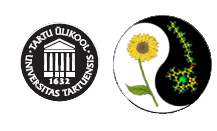Selective spectroscopy of photosynthetic complexes and biomolecules
Various pigmented molecules, among them chlorophylls in different chemical forms are involved in the photosynthetic process of plants and bacteria. The photoactive part of most photosynthetic complexes constitutes from closely packed, non-covalently bound pigments whose electronic properties are modified by the binding sites of the surrounding protein. To advance our comprehension of the photosynthetic light harvesting and charge separation processes the aggregated pigments are involved in, the properties of the individual pigments should be understood in greater detail than available so far.
We have applied a variety of conventional and selective spectroscopy techniques for studying vibronic spectra of chlorophyll a (Chl-a) and bacteriochlorophyll a (BChl-a) molecules in frozen solvents at low temperatures. A site-selective technique advanced in this laboratory and referred to as difference fluorescence line-narrowing (DFLN) spectroscopy was used for a detailed description of the electron–phonon and electron–vibrational (vibronic) coupling strengths. The electron–phonon coupling strength characterized by a Huang–Rhys factor, Sph, was found to depend strongly on the excitation wavelength within the inhomogeneously broadened Qy origin absorption band.
In the Chl-a doped 1-propanol frozen glass, for example, the Sph increases almost linearly from about 0.4 at 669 nm to about 0.6 at 693 nm, showing an unexpected direct correlation between the electron–phonon coupling strength and the electronic transition energy. In contrast, the vibronic coupling strength Svib=0.53 was found to be independent on the excitation wavelength.
In the LH1-RC core complex from the thermophilic photosynthetic purple sulfur bacterium Thermochromatium tepidum the effective electron–phonon coupling strength Sph and its dependence on wavelength was obtained, from about 1.6 at 950 nm to about 2.2 at 958 nm. Similarly large and wavelength dependent Huang–Rhys factors were found in the LH1 and LH2 antenna complexes from nonsulfur purple bacteria Rhodobacter sphaeroides and Rhodoblastus acidophilus.
Figure 1. Spectral hole burning (SHB) and fluorescence line-narrowing (FLN). The inhomogeneously broadened low-temperature absorption (blue line) and fluorescence (red line) spectra of chlorine-doped 1-propanol glass at 4.5 K. The insets show a series of narrow deep holes in the hole burning spectrum, and a DFLN spectrum (excited at 632 nm), consisting of a narrow zero-phonon line (ZPL), which is accompanied by a broad phonon sideband (PSB) and several vibronic replicas of ZPL+PSB.
Figure 2. Spectral hole burning (SHB). Upper part illustrates the IDF before and after hole burning. The photoproduct spectrum as well as PSB is neglected. The SHB spectrum (difference between two absorption spectra taken before and after the hole burning step) revealing a narrow ZPL at the burn frequency, flanked by real- and pseudo-PSBs due to electron–phonon coupling, is shown by a solid black line. A relative wavenumber scale is used, with 0 cm–1 placed at the burn frequency. The width (fwhm) of the IDF is 80 cm–1, the relative position of IDF is 12 cm–1, the mean phonon frequency is 22 cm–1, the Huang–Rhys factor Sph=0.5. The low-frequency Gaussian wing of the empirical PSB has a half-width of 20 cm–1, while its high-frequency Lorentzian wing has a half-width of 70 cm–1.
Figure 3. Fluorescence line-narrowing (FLN). The FLN spectrum revealing a narrow ZPL at the excitation frequency, accompanied by a phonon sideband is shown by a red line. The components of apparent sideband (real-, pseudo- and multi-PSBs) are indicated by colored lines. The ZPL is obscured by the scattered laser beam. Parameters are listed in the caption of Fig. 2.
Figure 4. Difference fluorescence line-narrowing (DFLN). The DFLN spectrum (difference between two FLN spectra taken before and after the hole burning step) revealing a narrow ZPL at the excitation frequency accompanied by a real phonon sideband, is shown by a red line. The intense ZPL free from scattered laser is truncated at level of ~5%. Parameters are listed in the caption of Fig. 2.
Figure 5. Homogeneous fluorescence spectrum of Ca-LH1-RC core complex from Tch. tepidum at 4.5 K obtained by high resolution DFLN technique.
Figure 6. Homogeneous fluorescence spectrum of peripheral LH2 complex from Rb. acidophilus at 4.5 K obtained by high resolution DFLN technique.
By using SHB technique:
- homogeneous linewidth, excited state lifetime, energy transfer time
- inhomogeneous distribution function, IDF
- energetic structure of excited state
- electron–phonon coupling strength, Sph
- coupling strength of nearest-neighbor chromophores (by SHB + high-pressure)
- electric dipole moment change (by SHB + electric field)
By using FLN and DFLN technique:
- vibrationally resolved spectra, ground and excited state modes
- chromophore identification and/or structural characterization
- electron–phonon coupling strength, Sph (by DFLN)
- vibronic coupling strength, Svib (by DFLN)
